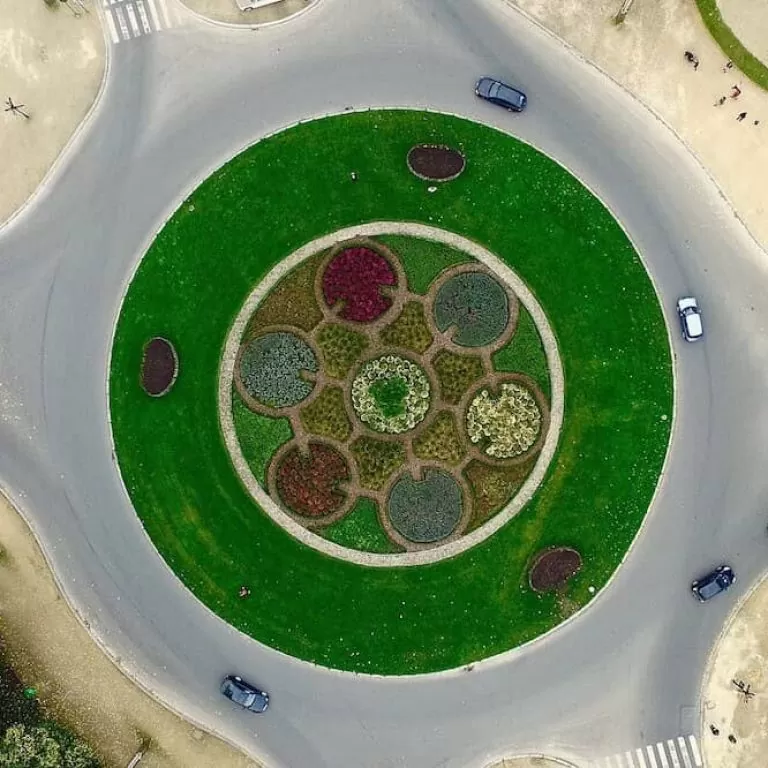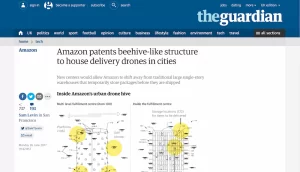
News Safety and potential – a balancing act for drones
The future of drones is still very much “in flux”, observes Andy Miah, Chair in Science Communication & Future Media at the University of Salford.
“But one thing is clear”, he says, “the investment capital is there to sustain [drone] applications for a long time to come and there is no sign of the number of applications diminishing [which means] there’s still a great deal of change to expect ahead.”
In recent months, there have been several major developments in terms of how unmanned aerial vehicles (UAVs) are being utilised to advance certain services across a variety of different sectors.

Amazon’s beehive-style distribution centre
A potentially game changing development from Amazon, for example, came in the form of their own patent for beehive-like drone centres, which will enable the online retailer to coordinate speedy aerial deliveries in central metropolitan areas.
This proposed application for drones is part of the company’s futuristic initiative to reshape the way their customers receive packages.
These “multi-level fulfilment centers” could potentially house large volume of drone systems, a base controlling their flight, as well as a place that they can recharge on site. Amazon also wish to incorporate more traditional modes of delivery, allowing for vehicle deliveries, as well as a self-service location for customers to pick up items in person.
Drone dangers
This announcement comes amid ongoing fears about the dangers that drones present to the public.
Reports about the misuses of UAVs are becoming increasingly frequent as they have rapidly ascended to become a billion-dollar cultural phenomenon.
Inadvertent breaching of airspace has led to legislative action by the Civil Aviation Authority. Many incidents of drones flying over airports have been reported, sometimes causing runway closures, flight delays and landing diversions.
Privacy breaches are also of concern; when equipped with a camera, UAVs can access images/ video of places/ subjects/ objects that are usually restricted or out of reach.
Drones also pose security risks for the Prison Service, as they have reportedly been used on multiple occasions to deliver drugs and mobile phones to prisoners.
Striking a balance
In attempts to curb the number of these kinds of incidents in the future, the UK government have announced plans to introduce drone registration and safety awareness courses to educate owners of drones weighing over 250 grams.
This means that potential flyers will have to take a test to prove that they fully understand all regulations surrounding drone flight. These governmental plans also include modifying all drone models using geo-fencing (the creation of a virtual perimeter relative to a real-world geographic area), so that these vehicles are automatically programmed to avoid no-fly zones.
There is no concrete timescale for when these plans will be implemented as the specifics of such regulations need to be carefully considered.
As the Aviation Minister Lord Martin Callanan explains, drones are increasingly becoming a vital tool for transport and other public services, so it is vital that such measures “prioritise protecting the public while maximising the full potential of drones”.
The growing applications of drone technology in public services, as well as by international space agencies, is testament to just how important these vehicles are now considered to be.
Developments are underway so that drones may be utilised in a variety of ways to aid society. Some of these include:
- Autonomous travel in Dubai
- Monitoring traffic and inspecting transport infrastructure
- Delivering vital medical equipment in emergencies
- Suspect tracking and counter-terrorism operations
- Environmental conservation
- Journalism
When used in combination with photography, the benefits of using drones extend far beyond those relating to our existence here on Earth.
‘Out of this world’ benefits
The medium of photography in and of itself has revolutionised how scientists and astrologists monitor change from outer space, as well as how they disseminate research findings.
While monitoring Earth from outer space seems to be taken care of, the International Space Station have started to utilise camera-equipped drones to capture the activities of the astronauts aboard the International Space Station.
Before now, the responsibility of taking photographs to record their work and lives in outer space has been left to the astronauts themselves. The Internal Ball Camera means that they no longer need to do this. The drone camera can function in a zero-gravity environment while being operated from Earth.
The commercial benefits of drones are also an important factor in their industrial success.
Creative applications in film and television are notable, with the world’s first Drone Film Festival taking place in New York back in 2015. In this sense, drone cinematography is now considered an art in and of itself, creating innovative means of visual expression, a new burgeoning industry, and worldwide community.
If that is not enough, the United Arab Emirates created the world’s first Drone Racing Grand Prix in 2016, which has since precipitated an entire community of drone-racing events all over the world, and is now considered a professional sport.
There are fundamental concerns (and forthrightly so) about what the evolution of drone technology may bring,with official legislation and restrictions still lacking in some areas.
But with fully qualified and trained professionals offering their services to both other businesses and individuals, the safe use of UAVs continues to prove a popular tool across a number of sectors and for a wide range of applications.